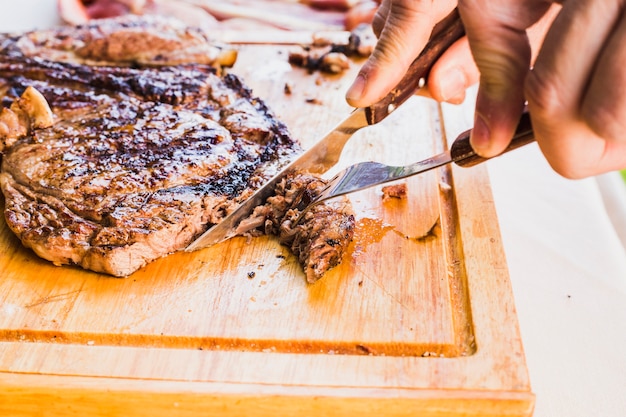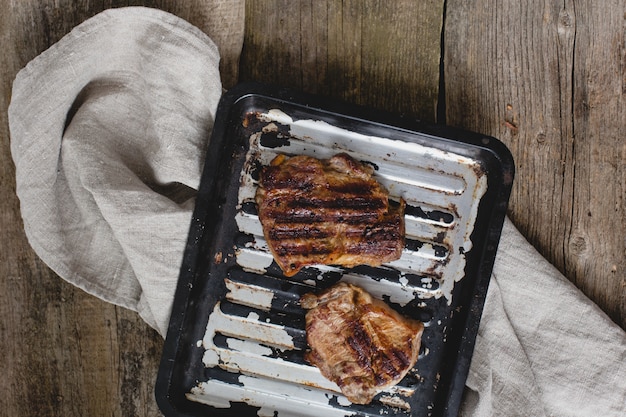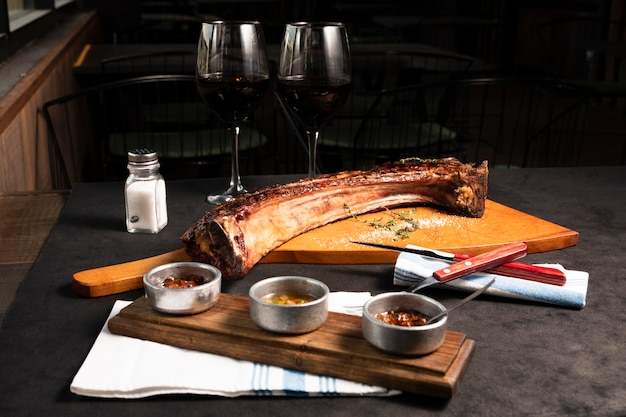Part 1: choosing the right cut - The Cast of Characters

The Big Guns:
- rib roast: This is the granddaddy of roasts, the one that demands attention. It’s packed with flavour and boasts a beautiful marbling of fat, ensuring it’s juicy and tender. However, be warned, these are often hefty beasts, so prepare for a commitment. I remember the first time I tackled a rib roast. I thought I'd overestimated my oven's capacity! But the result was a symphony of deliciousness that justified every ounce of effort.
- sirloin roast: This is the reliable workhorse, always delivering a satisfying performance. It’s known for its tenderness and slightly leaner profile, making it perfect for slicing and serving. A Sirloin roast is a classic choice for a Sunday roast dinner, guaranteed to please even the most discerning guests.
The Middleweights:
- chuck roast: This is the underdog, often overlooked but packed with potential. It's tougher than its pricier cousins, but slow cooking transforms it into a masterpiece of melt-in-your-mouth tenderness. Think rich, hearty stews and slow-cooked roasts that fall apart with the gentlest nudge of a fork. I love a good Chuck Roast for a wintery meal – it’s the kind of dish that warms you from the inside out.
- eye of round roast: This leaner cut is perfect for those who prefer less fat. It’s versatile and can be cooked a variety of ways, but it requires careful attention to avoid dryness. I once tried to cook an Eye of Round roast a bit too long, and it ended up a bit dry. Lesson learned: keep a watchful eye on those lean cuts!
The Underdogs:
- top round roast: A close relative of the Eye of Round, this lean cut is known for its affordability. It's best for slicing thinly, making it ideal for sandwiches or salads. Don't underestimate this little guy – it's packed with flavour, especially when seasoned well.
- flank steak: While not technically a roast, Flank steak is a fantastic option for those seeking a lean and flavourful cut. It’s perfect for stir-fries, fajitas, or grilling. I love a good Flank steak for a quick and easy weeknight meal. Just a bit of marinating and it's ready for the grill!
Part 2: The Temperature Tango: Internal vs. Oven

Oven Temperature: The Initial Heat
Generally, you’ll want to start with a hot oven, around 400°F (200°C). This initial burst of heat helps to sear the roast, creating a delicious crust that locks in the juices. It’s like giving your roast a quick workout before the main event. But then, we need to cool things down a bit.
internal temperature: The Main Event
This is the real star of the show, the one that ensures your roast is cooked to perfection. Here’s where a good meat thermometer is your best friend. It allows you to monitor the internal temperature of the roast and cook it to your desired level of doneness.
| Doneness | Internal Temperature (°F) | Internal Temperature (°C) |
|---|---|---|
| Rare | 125-130 | 52-54 |
| Medium-Rare | 130-135 | 54-57 |
| Medium | 140-145 | 60-63 |
| Medium-Well | 150-155 | 65-68 |
| Well-Done | 160 | 71 |
Important Note:
Always cook your beef roast to an internal temperature of at least 145°F (63°C) to ensure it’s safe to eat. This is especially important for larger roasts, as they take longer to cook through. I once took a shortcut and didn't use a thermometer, thinking I could judge the doneness by eye. Big mistake! The roast was undercooked, and I had to throw it back in the oven. Trust me, a meat thermometer is your culinary guardian angel.
Part 3: Time to Cook! A Culinary Countdown

Preparing the Star: A Quick Dress Rehearsal
Start by giving your roast a quick makeover. Pat it dry with paper towels, then season it liberally with salt and pepper. This creates a flavorful base, ready to absorb additional seasonings. If you’re feeling adventurous, experiment with your favorite herbs and spices. I’ve found that a sprinkle of rosemary and thyme adds a wonderful aroma and depth of flavour to my roasts.
The Searing Ritual: Setting the Scene
Preheat your oven to 400°F (200°C). While the oven warms, grab a large skillet and heat it over high heat. Now, we’re going to stage a dramatic scene – searing the roast! This creates a beautiful golden-brown crust and locks in the juices, adding both flavor and visual appeal. Seare it on all sides, ensuring a uniform browning. I love the sound of the roast sizzling in the pan – it's a sure sign that a delicious meal is on its way.
The Main Act: roasting time
Once your roast is beautifully seared, transfer it to a roasting pan and place it in the preheated oven. Now it’s time to reduce the heat to 325°F (160°C). We’re aiming for a slow and steady cook, allowing the meat to reach the perfect internal temperature without drying out. Here's a general guideline for roasting time:
- Small Roast (3-4 lbs): 1 1/2 - 2 hours
- Medium Roast (5-7 lbs): 2 - 3 hours
- Large Roast (8-10 lbs): 3 - 4 hours
The Curtain Call: Resting for a Grand Finale
Once your roast reaches the desired internal temperature, take it out of the oven and let it rest for at least 15 minutes before carving. This might seem like an unnecessary step, but it's essential for achieving a truly tender and juicy roast. During this resting time, the juices redistribute throughout the meat, resulting in a perfect culinary encore. I’ve learned the hard way that rushing the resting process can lead to a dry and disappointing roast. Patience is key in this final act!
Part 4: Advanced Techniques: Mastering the Stagecraft
You've got the basics down, but now let's explore some techniques to elevate your beef roast game. Think of it as adding some extra flair and finesse to your culinary production.Basting for Juiciness: A Touch of Moisture
Basting your roast with pan drippings or broth during cooking keeps it moist and flavourful. Use a spoon or basting brush to generously coat the roast with these flavorful liquids every 30 minutes or so. It's like giving your roast a gentle, nourishing rain shower.
Vegetables for Flavor: Supporting Actors
Why not turn your roast into a one-pan masterpiece? Place your favourite root vegetables, such as carrots, potatoes, and onions, around the roast. They’ll absorb the delicious juices, becoming deliciously caramelized and adding a delightful side dish to your main event. It's a win-win situation!
Wine or Broth for Depth: Enriching the Production
A splash of red wine or beef broth added to the bottom of the roasting pan creates a rich and flavorful gravy. It's like adding a dramatic musical score, enhancing the depth and complexity of your roast. I love adding a splash of red wine to my roasts – it adds a hint of sweetness and complexity that perfectly complements the savory flavor of the beef.
Part 5: The All-Important Gravy: The Culinary Soundtrack
No beef roast is complete without a symphony of flavours, and that symphony wouldn't be complete without a rich and flavorful gravy.The Basic Gravy: A Classic Score
Once your roast is resting, pour off the excess fat from the roasting pan. Add a tablespoon of flour and whisk it into the remaining drippings. Slowly add about 1 cup of beef broth or water, whisking constantly until the gravy is smooth and thickened. Season with salt and pepper to taste. This is the basic foundation for a delicious gravy, but there's always room for improvisation.
Elevating the Gravy: A Symphony of Flavors
Want to take your gravy from good to great? Experiment with different seasonings. Add a splash of red wine, a tablespoon of Dijon mustard, or even a dash of Worcestershire sauce for a unique twist. You can also thicken it with cornstarch or a roux for a smoother, silkier consistency. I often add a teaspoon of brown sugar to my gravy for a hint of sweetness that perfectly balances the savory flavours.
Part 6: Leftovers? No Problem! The Encore
The beauty of a beef roast is that the best part often comes after the main event. Leftovers are a culinary treasure trove, offering a chance to enjoy the deliciousness of the roast in a whole new way.Sandwiches, Anyone?
Who doesn’t love a juicy beef roast sandwich? Slice up the leftover roast, add your favourite toppings like cheese, pickles, and mustard, and enjoy! I always keep a stash of crusty bread on hand for this purpose – it’s the perfect vehicle for delivering a delicious roast sandwich experience.
Soup for the Soul:
Shred the leftover roast and add it to your favourite soup recipe. It’s a great way to add extra protein and flavour to any soup. I love adding shredded beef roast to a classic beef stew or a hearty lentil soup – it gives it an extra boost of flavour and substance.
Beef Hash Anyone?
Dice the leftover roast and combine it with potatoes, onions, and your favourite spices. Fry it all up for a delicious and filling meal. Beef hash is a classic comfort food – it’s warm, hearty, and always a satisfying choice for a quick and easy meal.
Beef and Bean Burritos:
Shred the leftover roast and add it to your favourite burrito recipe. It’s a quick and easy way to use up leftovers and create a flavorful and filling meal. I often add a spoonful of salsa and a dollop of sour cream to my beef and bean burritos – it adds a bit of freshness and tanginess to the dish.
Part 7: Tips for Success: The Director's Notes
I’ve learned a lot over the years, and I'm happy to share my wisdom. Here are some tips to ensure your beef roast turns out perfectly every time.Don’t Overcrowd the Pan: Spacious Stagecraft
Make sure your roasting pan is big enough to accommodate your roast. Overcrowding the pan will hinder even cooking and could lead to steaming rather than roasting. I learned this lesson the hard way when I tried to fit a large roast into a small pan. The result was a unevenly cooked roast that was a bit disappointing. Always choose a pan that gives your roast plenty of room to shine.
Use a Meat Thermometer: The Culinary Gauge
This is your best friend, the one that guarantees a perfectly cooked roast. Don’t rely on your eyes or guesswork – a meat thermometer is your culinary compass. I always keep a meat thermometer on hand – it's essential for ensuring my roasts are cooked to perfection, every time.
Don’t Be Afraid to Experiment: Embrace Culinary Creativity
Cooking is all about creativity, so experiment with different seasonings, marinades, and cooking methods to find your perfect beef roast recipe. I love adding a touch of ginger and garlic to my roast for an Asian-inspired twist. Sometimes, I'll try a smoky paprika rub or a blend of herbs de Provence. The possibilities are endless!
Part 8: FAQs: Answering the Call
I know you’re full of questions, so let’s address some common ones about beef roasts.Q: How do I know if my roast is done?
A: As I mentioned before, a meat thermometer is your best friend. Insert it into the thickest part of the roast, avoiding any bones. When it reaches the desired internal temperature, your roast is ready!
Q: How can I tell if my roast is too dry?
A: If your roast is dry, it usually means it was overcooked. But don't despair – there's still hope! Slice the roast thinly and add it to a soup or stew to give it extra flavour. You can also try making a delicious beef hash with the leftover meat. It's amazing how a few simple dishes can transform a dry roast into a culinary delight.
Q: Can I freeze leftover roast beef?
A: Absolutely! Wrap the leftover roast tightly in plastic wrap and aluminum foil and freeze for up to 3 months. When you’re ready to enjoy it, thaw it in the refrigerator overnight and reheat it in the oven or microwave.
Q: What are some good side dishes to serve with beef roast?
A: The possibilities are endless! Classic choices include mashed potatoes, roasted vegetables, gravy, and Yorkshire pudding. But don't be afraid to get creative and try something new. I love serving my beef roast with a side of roasted brussels sprouts, roasted asparagus, or a delicious potato gratin.
Q: How do I make a delicious gravy with pan drippings?
A: The key to a great gravy is to start with good pan drippings. After you remove the roast, pour off any excess fat from the roasting pan. Add a tablespoon of flour and whisk it into the drippings. Slowly add about 1 cup of beef broth or water, whisking constantly until the gravy is smooth and thickened. Season with salt and pepper to taste. You can also add a splash of red wine or a tablespoon of Dijon mustard to give your gravy an extra layer of flavor.
And there you have it! Your ultimate guide to cooking the perfect beef roast. Go forth and impress your friends and family with a delicious and unforgettable meal. Remember, cooking is about having fun and embracing creativity, so don’t be afraid to experiment and find what works best for you. Happy roasting!Everyone is watching

Corn on the Cob: The Ultimate Guide to Perfectly Cooked Ears
Healthy MealsAh, corn on the cob. Just the name evokes images of sunny days, barbecues, and that sweet, juicy flavour that ...

Scallops: The Ultimate Guide to Perfect Cooking
Healthy MealsAh, scallops. Those delicate, sweet, and utterly delicious morsels of the sea. They hold a special place in my...

Spaghetti Squash: The Ultimate Guide to Cooking and Serving
Healthy MealsRemember that time you saw spaghetti squash at the supermarket, looking all bumpy and strange, and thought, "W...

Salmon Cooking Times: Perfect Guide for Every Recipe
Healthy MealsLet me tell you, cooking salmon is an art form. It's all about getting that perfect balance: juicy and tender,...

Ham Cooking Time: How Long to Bake, Smoke, or Boil a Delicious Ham
Healthy MealsAh, ham. It's a classic, isn't it? A real crowd-pleaser, especially around holidays. And when done right, it'...
